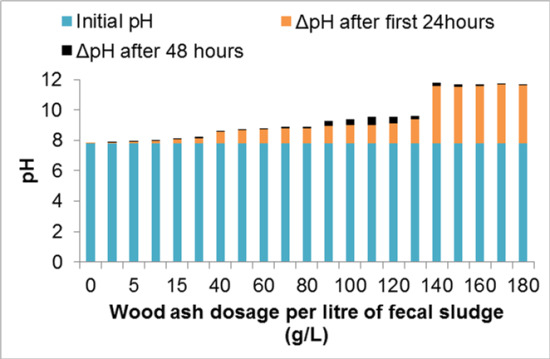Sanitizing Fecal Sludge for Reuse Using Wood Ash as an Additive
Abstract
:1. Introduction
2. Experimental Section
3. Results and Discussion
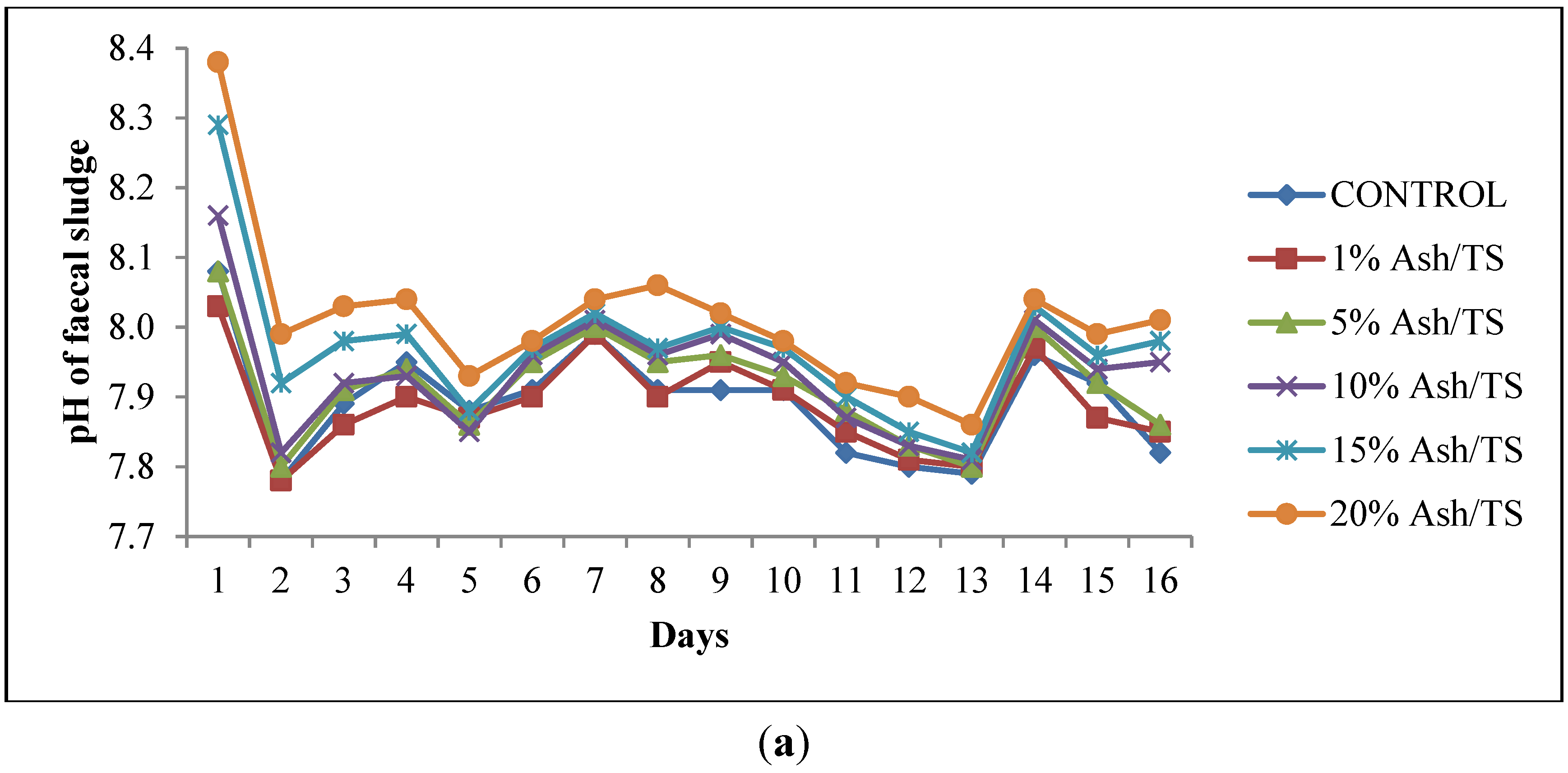
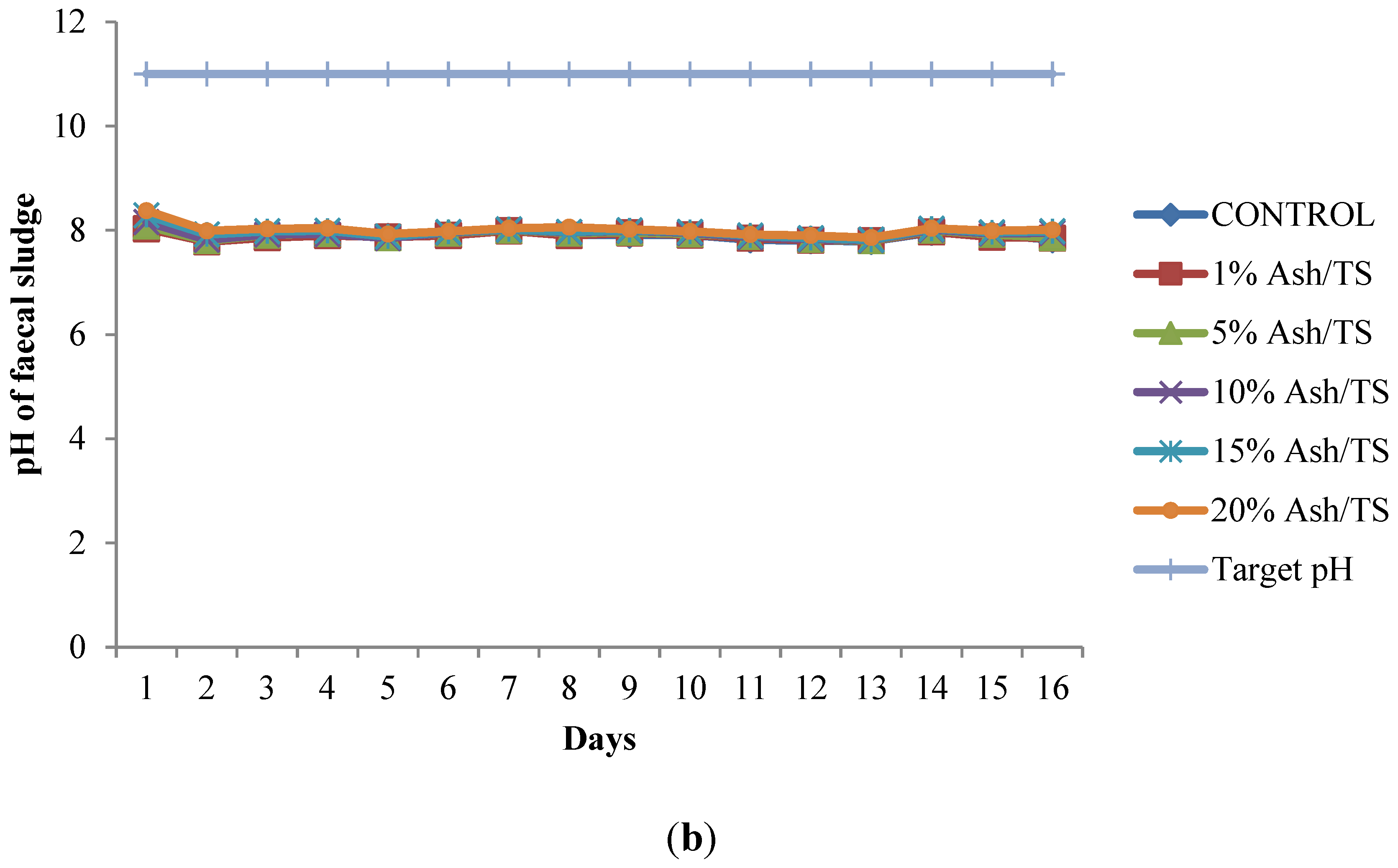
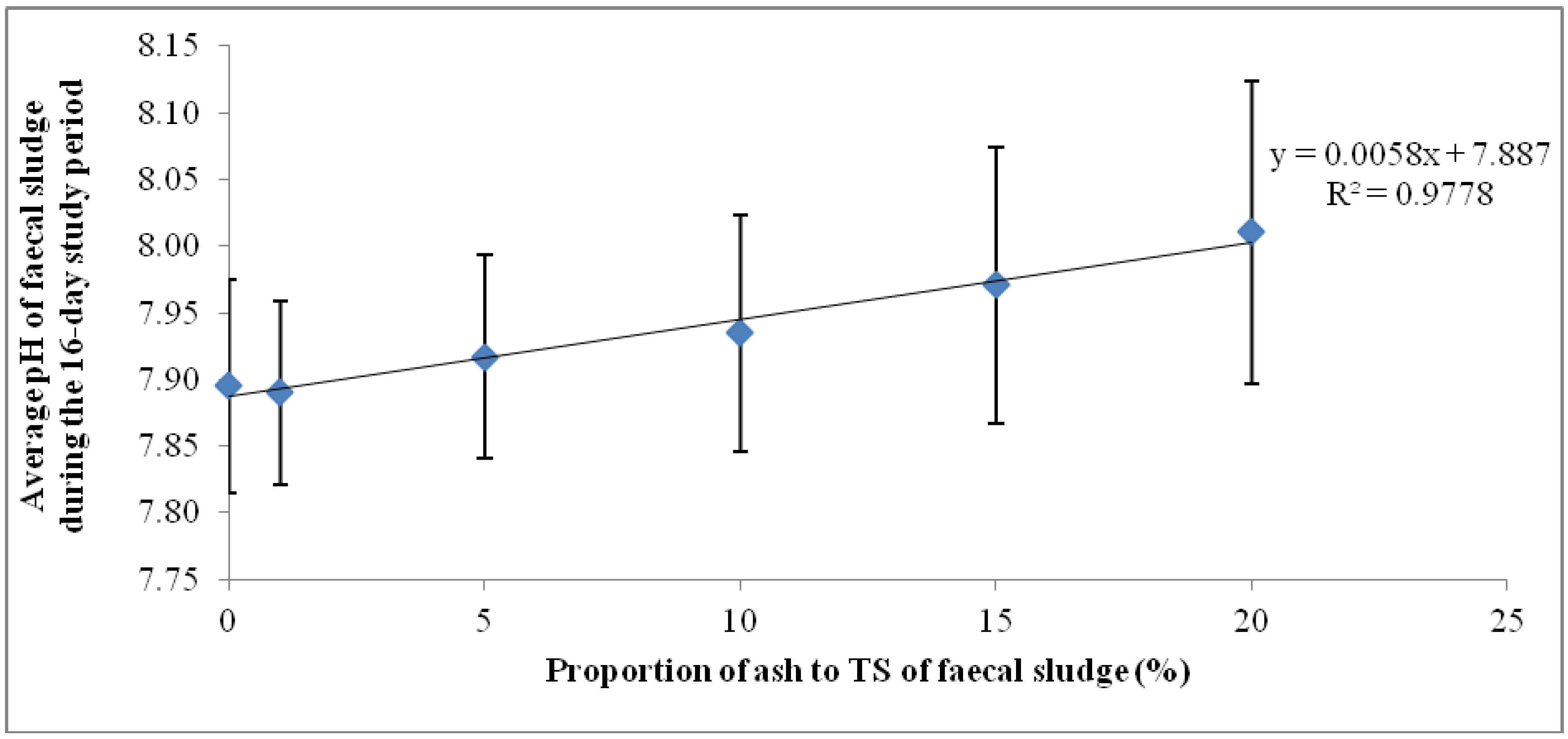
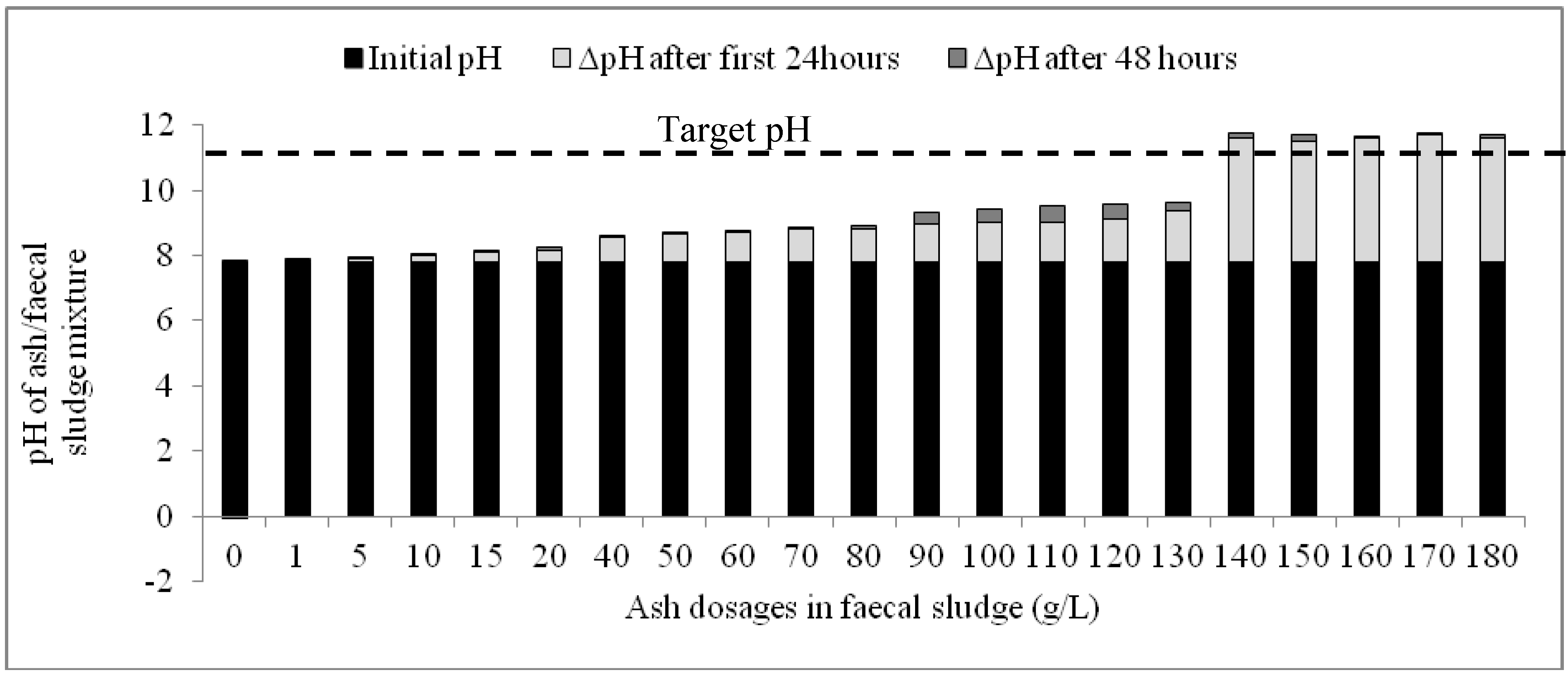
| Additive | Dosage (g/L) | pH of Faecal Sludge | pH of Mixture after 24 h |
|---|---|---|---|
| Lime [21] | 9.8 | 6.6 | 10.7 * |
| 21.3 | 6.6 | 12.5 | |
| Ash (This study) | 140 | 7.81 | 11.59 |
| 180 | 7.81 | 11.60 |
4. Conclusions
Acknowledgments
Author Contributions
Conflicts of Interest
References
- Schönning, C.; Stenström, T.A. Guidelines on the Safe Use of Urine and Faeces in Ecological Sanitation Systems; Stockholm Environment Institute: Stockholm, Sweden, 2004. [Google Scholar]
- Dreschel, P.; Cofie, O.; Danso, G. Closing the Rural-Urban Food and Nutrient Loops in West Africa: A Reality Check. Urban Agric. Mag. 2010, 23, 8–10. [Google Scholar]
- Beal, C.; Gardner, T.; Ahmed, W.; Walton, C.; Hamlyn-Harris, D. Closing the nutrient loop: a urine-separation and reuse trial in the Currumbin ecovillage, QLD. In Innovation and Technology for On-site Systems: Proceedings of On-site 2007 Conference; University of New England: Armidale, Australia, 2007; pp. 59–66. [Google Scholar]
- Mosiej, J.; Karczmarczyk, A. Closing the nutrient loop between urban and rural area—Wastewater and sludge utilization in Ner River Valley. Ecohydrol. Hydrobiol. Ecohydrol. Implement. Eur. Water Framew. Dir. 2006, 6, 197–203. [Google Scholar] [CrossRef]
- Jensen, P.K.; Phuc, P.D.; Dalsgaard, A.; Konradsen, F. Successful sanitation promotion must recognize the use of latrine wastes in agriculture—The example of Vietnam. WHO Bull. 2005, 83, 273–274. [Google Scholar]
- Phuc, P.D.; Konradsen, F.; Phuong, P.T.; Cam, P.D.; Dalsgaard, A. Use of human excreta as fertilizer in agriculture in Nghe An province, Viet Nam. Southeast Asian J. Trop. Med. Public Health 2006, 37, 222–229. [Google Scholar] [PubMed]
- World Health Organization. Guidelines for the Safe Use of Wastewater, Excreta and Greywater: Wastewater Use in Agriculture, 2; WHO: Geneva, Switzerland, 2006. [Google Scholar]
- World Health Organization. Guidelines for the Safe Use of Wastewater, Excreta and Greywater: Excreta and Greywater Use in Agriculture, 4; WHO: Geneva, Switzerland, 2006. [Google Scholar]
- Chaggu, E.J. Sustainable Environmental Protection Using Modified Pit-Latrines. Ph.D. Thesis, Wageningen University, Wageningen, The Netherlands, 2004. [Google Scholar]
- Niwagaba, B.C. Treatment Technologies for Human Faeces and Urine. Ph.D. Thesis, Swedish University of Agricultural Sciences, Uppsala, Sweden, 2009. [Google Scholar]
- Laboy-Nieves, E.N.; Schaffner, F.C.; Abdelhadi, A.H.; Goosen, M.F.A. Environmental Management, Sustainable Development and Human Health; Taylor and Francis Group: Boca Raton, FL, USA, 2008. [Google Scholar]
- Strande, L.; Ronteltap, M.; Brdjanovic, D. Faecal Sludge Management: Systems Approach for Implementation and Operation; IWA Publishing: London, UK, 2014; pp. 45–64. [Google Scholar]
- Cofie, O.; Agbottah, S.; Strauss, M.; Esseku, H.; Montangero, A.; Awuah, E.; Kone, D. Solid–liquid separation of faecal sludge using drying beds in Ghana: Implications for nutrient recycling in urban agriculture. Water Res. 2006, 40, 75–82. [Google Scholar] [CrossRef] [PubMed]
- Koné, D.; Gallizzi, K.; Drescher, S.; Cofie, O.; Zurbrugg, C.; Forster, D.; Montangero, A.; Awuah, E.; Strauss, M. Efficiency of Helminth eggs removal in dewatered faecal sludge by co-composting. In Proceedings of the 30th WEDC International Conference on People-Centered Approaches to Water and Environmental Sanitation, Vientiane, Laos, 25–28 October 2004.
- Mensah, P.Y.; Kuffour, R.A.; Baidoo, P.K.; Awuah, E. The effect of different percentages of bulking agent (sawdust) on microbial quality of faecal sludge. Water Sci. Technol. 2013, 67, 1728–1733. [Google Scholar] [CrossRef] [PubMed]
- Mara, D. Domestic Wastewater Treatment in Developing Countries; Earthscan: London, UK, 2004; pp. 85–182. [Google Scholar]
- Cabirol, N.; Oropeza, M.R.; Noyola, A. Removal of helminth eggs and faecal coliforms by anaerobic thermophilic sludge digestion. Water Sci. Technol. 2002, 45, 269–274. [Google Scholar] [PubMed]
- Koné, D.; Cofie, O.; Zurbrugg, C.; Gallizzia, K.; Mosera, D.; Dreschera, S.; Strauss, M. Helminth eggs inactivation efficiency by faecal sludge dewatering and co-composting in tropical climates. Water Res. 2007, 6. [Google Scholar] [CrossRef] [PubMed]
- Andreasen, P. Chemical Stabilization Sludge into Biosolids: Processing, Disposal, Utilization; Spinosa, L., Vesilind, P.A., Eds.; IWA Publishing: London, UK, 2001. [Google Scholar]
- Kazama, S.; Otaki, M. Mechanism for Inactivation of Bacteria and Viruses in Sawdust Used in Composting Toilet. J. Water Environ. Technol. 2011, 9, 53–66. [Google Scholar] [CrossRef]
- Bina, B.; Movahedian, H.; Kord, I. The Effect of Lime Stabilization on the Microbiological Quality of Sewage Sludge. Iran. J. Environ. Health Sci. Eng. 2004, 1, 34–38. [Google Scholar]
- Boost, M.V.; Poon, C.S. The effect of a modified method of lime-stabilisation sewage treatment on enteric pathogens. Environ. Int. 1998, 24, 783–788. [Google Scholar] [CrossRef]
- World Health Organization. Guidelines for the Safe Use of Wastewater and Excreta in Agriculture and Aquaculture: Measures for Public Health Protection. WHO: Geneva, Switzerland, 1989; Available online: http://apps.who.int/iris/handle/10665/41681 (11 September 2015).
- Magri, M.E.; Philippi, L.S.; Vinneras, B. Inactivation of Pathogens in Feces by Desiccation and Urea Treatment for Application in Urine-Diverting Dry Toilets. Appl. Environ. Microbiol. 2013, 79, 2156–2163. [Google Scholar] [CrossRef] [PubMed]
- Taweesan, A.; Koottatep, T.; Polprasert, C. Effective faecal sludge management measures for on-site sanitation systems. J. Water Sanit. Hyg. Dev. 2015, 5, 483–492. [Google Scholar] [CrossRef]
- Vodounhessi, A.; von Münch, E. Financial Challenges to Making Faecal Sludge Management an Integrated Part of the Ecosan Approach: Case Study of Kumasi, Ghana. Water Pract. Technol. 2006, 1, 1–8. [Google Scholar] [CrossRef]
- Ingallinella, A.M.; Sanguinetti, G.; Koottatep, T.; Montangero, A.; Strauss, M. The challenge of faecal sludge management in urban areas—Strategies, regulations and treatment options. Water Sci. Technol. 2002, 46, 285–294. [Google Scholar] [PubMed]
- Huibers, F.P.; Seghezzo, L.; Mels, A. Wastewater and Irrigated Agriculture Lessons Learned and Possible Applications in Africa. Afr. Technol. Policy Stud. Netw. Spec. Paper Ser. No. 23 2006, 12, 1–12. [Google Scholar]
- American Public Health Association. Standard Methods for the Examination of Water and Wastewater, 20th ed.; American Public Health Association: Washington, DC, USA, 1999. [Google Scholar]
- Campbell, A.G. Recycling and Disposing of Wood Ash. Tappi J. 1990, 9, 141–145. [Google Scholar]
- Adekayode, F.O.; Olojugba, M.R. The utilization of wood ash as manure to reduce the use of mineral fertilizer for improved performance of maize (Zea mays L.) as measured in the chlorophyll content and grain yield. J. Soil Sci. Environ. Manag. 2012, 1, 40–45. [Google Scholar]
- Reid, C.; Watmough, S.A. Evaluating the effects of liming and wood-ash treatment on forest ecosystems meta-analysis. Can. J. For. Res. 2014, 44, 867–885. [Google Scholar] [CrossRef]
- Pitman, R.M. Wood ash use in forestry—A review of the environmental impacts. Forestry 2006, 79, 563–588. [Google Scholar] [CrossRef]
- Wurts, W.A. Daily pH Cycle and Ammonia Toxicity. World Aquac. 2003, 34, 20–21. [Google Scholar]
- Patoczka, J.; Wilson, D.J. Kinetics of the desorption of ammonia from water by diffused aeration. Sep. Sci. Technol. 1984, 19, 77–93. [Google Scholar] [CrossRef]
- Gulyas, H.; Zhang, S.; Otterpohl, R. Pretreating stored human urine for solar evaporation by low-technology ammonia stripping. J. Environ. Prot. 2014, 5, 962–969. [Google Scholar] [CrossRef]
- Pescon, B.M.; Barrios, J.A.; Jimenez, B.E.; Nelson, K.L. The effects of temperature, pH, and ammonia concentration on the inactivation of Ascaris eggs in sewage sludge. Water Res. 2007, 41, 2893–2902. [Google Scholar] [CrossRef] [PubMed]
- Farzadkia, M.; Jaafarzadeh, N.; Loveimi, A. Optimization of bacteriological quality of biosolids by lime addition. Iran. J. Environ. Health. Sci. Eng. 2009, 6, 29–34. [Google Scholar]
© 2015 by the authors; licensee MDPI, Basel, Switzerland. This article is an open access article distributed under the terms and conditions of the Creative Commons Attribution license (http://creativecommons.org/licenses/by/4.0/).
Share and Cite
Monney, I.; Awuah, E. Sanitizing Fecal Sludge for Reuse Using Wood Ash as an Additive. Recycling 2016, 1, 14-24. https://doi.org/10.3390/recycling1010014
Monney I, Awuah E. Sanitizing Fecal Sludge for Reuse Using Wood Ash as an Additive. Recycling. 2016; 1(1):14-24. https://doi.org/10.3390/recycling1010014
Chicago/Turabian StyleMonney, Isaac, and Esi Awuah. 2016. "Sanitizing Fecal Sludge for Reuse Using Wood Ash as an Additive" Recycling 1, no. 1: 14-24. https://doi.org/10.3390/recycling1010014
APA StyleMonney, I., & Awuah, E. (2016). Sanitizing Fecal Sludge for Reuse Using Wood Ash as an Additive. Recycling, 1(1), 14-24. https://doi.org/10.3390/recycling1010014




